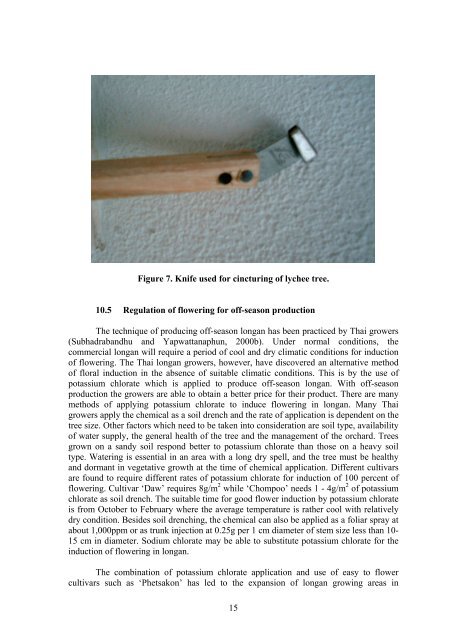Longan production in Asia - United Nations in Indonesia
Longan production in Asia - United Nations in Indonesia
Longan production in Asia - United Nations in Indonesia
Create successful ePaper yourself
Turn your PDF publications into a flip-book with our unique Google optimized e-Paper software.
Figure 7. Knife used for c<strong>in</strong>ctur<strong>in</strong>g of lychee tree.<br />
10.5 Regulation of flower<strong>in</strong>g for off-season <strong>production</strong><br />
The technique of produc<strong>in</strong>g off-season longan has been practiced by Thai growers<br />
(Subhadrabandhu and Yapwattanaphun, 2000b). Under normal conditions, the<br />
commercial longan will require a period of cool and dry climatic conditions for <strong>in</strong>duction<br />
of flower<strong>in</strong>g. The Thai longan growers, however, have discovered an alternative method<br />
of floral <strong>in</strong>duction <strong>in</strong> the absence of suitable climatic conditions. This is by the use of<br />
potassium chlorate which is applied to produce off-season longan. With off-season<br />
<strong>production</strong> the growers are able to obta<strong>in</strong> a better price for their product. There are many<br />
methods of apply<strong>in</strong>g potassium chlorate to <strong>in</strong>duce flower<strong>in</strong>g <strong>in</strong> longan. Many Thai<br />
growers apply the chemical as a soil drench and the rate of application is dependent on the<br />
tree size. Other factors which need to be taken <strong>in</strong>to consideration are soil type, availability<br />
of water supply, the general health of the tree and the management of the orchard. Trees<br />
grown on a sandy soil respond better to potassium chlorate than those on a heavy soil<br />
type. Water<strong>in</strong>g is essential <strong>in</strong> an area with a long dry spell, and the tree must be healthy<br />
and dormant <strong>in</strong> vegetative growth at the time of chemical application. Different cultivars<br />
are found to require different rates of potassium chlorate for <strong>in</strong>duction of 100 percent of<br />
flower<strong>in</strong>g. Cultivar ‘Daw’ requires 8g/m 2 while ‘Chompoo’ needs 1 - 4g/m 2 of potassium<br />
chlorate as soil drench. The suitable time for good flower <strong>in</strong>duction by potassium chlorate<br />
is from October to February where the average temperature is rather cool with relatively<br />
dry condition. Besides soil drench<strong>in</strong>g, the chemical can also be applied as a foliar spray at<br />
about 1,000ppm or as trunk <strong>in</strong>jection at 0.25g per 1 cm diameter of stem size less than 10-<br />
15 cm <strong>in</strong> diameter. Sodium chlorate may be able to substitute potassium chlorate for the<br />
<strong>in</strong>duction of flower<strong>in</strong>g <strong>in</strong> longan.<br />
The comb<strong>in</strong>ation of potassium chlorate application and use of easy to flower<br />
cultivars such as ‘Phetsakon’ has led to the expansion of longan grow<strong>in</strong>g areas <strong>in</strong><br />
15
















